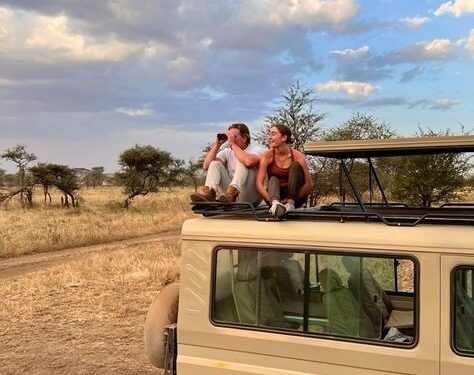The Magic of Safari: Exploring the Serengeti
Embarking on a safari in the Serengeti is more than just a vacation; it’s an unforgettable adventure that immerses travelers in the heart of nature. Known for its stunning landscapes, diverse wildlife, and the iconic Great Migration, the Serengeti National Park in Tanzania offers a unique experience for those seeking to connect with the wild. In this article, we delve into what makes a safari in the Serengeti so special, from the breathtaking scenery to the extraordinary wildlife encounters.
The Serengeti: A World Heritage Site
Established in 1951, the Serengeti National Park is one of Africa’s most famous national parks and a UNESCO World Heritage Site. Covering over 5,700 square miles, the park boasts a variety of ecosystems, including grasslands, savannas, riverine forests, and woodlands. Its vast expanses provide a habitat for an incredible array of wildlife, making it a prime destination for safari enthusiasts.
The name “Serengeti” comes from the Maasai word “Siringet,” which means “endless plains.” This description perfectly captures the breathtaking vistas that stretch as far as the eye can see, dotted with acacia trees and teeming with life.
The Great Migration: Nature’s Spectacle
One of the most awe-inspiring events in the Serengeti is the Great Migration, often referred to as the “Greatest Show on Earth.” Each year, approximately 1.5 million wildebeest, along with hundreds of thousands of zebras and other herbivores, migrate in search of greener pastures and water sources. This journey is fraught with challenges, as the animals must navigate treacherous river crossings and evade predators along the way.
The timing of the Great Migration varies, but it generally occurs between June and October, when the animals move from the Serengeti to the Maasai Mara in Kenya. Witnessing this migration is a once-in-a-lifetime experience, drawing visitors from around the globe who hope to capture the drama and beauty of nature.
River Crossings: A Thrilling Experience
One of the highlights of witnessing the Great Migration is observing the wildebeest river crossings, where thousands of animals bravely plunge into the crocodile-infested waters of the Mara River. The sight of these animals swimming for their lives, while predators lurk nearby, creates a palpable tension that leaves spectators breathless. Photographers often flock to these crossings to capture the dramatic moments, making it a bucket-list experience for wildlife enthusiasts.
Wildlife Encounters: A Diverse Ecosystem
Beyond the Great Migration, the Serengeti is home to an astonishing variety of wildlife. The park’s ecosystem supports a diverse range of species, including the Big Five: lions, leopards, elephants, buffaloes, and rhinoceroses. Each of these animals plays a crucial role in the ecosystem, contributing to the delicate balance of life in the Serengeti.
Big Cats of the Serengeti
The Serengeti is particularly famous for its big cats. Lions roam the grasslands in prides, often seen lounging in the shade or stalking their prey. Leopards can be spotted lounging in trees, their distinctive spots camouflaging them among the branches. Cheetahs, known for their incredible speed, can also be spotted racing across the plains in pursuit of prey.
Witnessing these majestic creatures in their natural habitat is a thrilling experience. Guided safari tours often include early morning or late afternoon drives when wildlife is most active, providing opportunities for close encounters and unforgettable memories.
Elephants and Other Wildlife
In addition to big cats, the Serengeti is home to large herds of elephants, which can often be seen roaming the savanna. These gentle giants are known for their intelligence and social behavior, making them a favorite among safari-goers. Other wildlife such as giraffes, hippos, and various antelope species add to the park’s rich biodiversity.
Birdwatchers will also find the Serengeti a paradise, with over 500 bird species recorded in the park. From vibrant lilac-breasted rollers to majestic African fish eagles, the avian life is varied and captivating.
Safari Experiences: Types of Safaris
There are various ways to experience a safari in the Serengeti, each offering a unique perspective on the wildlife and landscapes. Here are some popular options:
Game Drives
Game drives are the most common way to explore the Serengeti. Visitors can choose between half-day, full-day, or multi-day game drives, allowing them to cover different areas of the park. Comfortable safari vehicles with knowledgeable guides enhance the experience, providing insights into the wildlife and ecosystem.
Walking Safaris
For those seeking a more immersive experience, walking safaris offer a chance to explore the Serengeti on foot. Accompanied by trained guides, participants can learn about the smaller details of the environment, such as tracks, plants, and sounds of the wild. This intimate experience allows travelers to connect with nature in a profound way.
Hot Air Balloon Safaris
For a truly unique perspective, hot air balloon safaris provide breathtaking aerial views of the Serengeti’s landscapes and wildlife. Floating above the plains, participants can witness the vastness of the park and the movement of herds below. Many balloon safaris conclude with a champagne breakfast in the bush, adding a touch of luxury to the adventure.
Luxury Lodges and Camps
Accommodations in the Serengeti range from luxury lodges to tented camps, each offering a different experience. Luxury lodges often provide stunning views, exquisite dining, and spa services, while tented camps offer a more rustic and intimate experience, allowing guests to fall asleep to the sounds of the wilderness.
Cultural Encounters: The Maasai People
Engaging with the local Maasai community is another highlight of a safari experience in the Serengeti. The Maasai are a semi-nomadic pastoralist tribe known for their vibrant culture and distinctive dress. Many tour operators offer opportunities to visit Maasai villages, where travelers can learn about their customs, traditions, and way of life.
These cultural encounters provide a deeper understanding of the relationship between the Maasai and the land they inhabit. Visitors can participate in traditional dances, explore local craftsmanship, and gain insights into the challenges faced by the community in the modern world.
Conservation Efforts: Protecting the Serengeti
As tourism continues to grow, conservation efforts in the Serengeti are more crucial than ever. Various organizations and initiatives work to protect the park’s wildlife and natural habitats, ensuring that future generations can enjoy the beauty of this extraordinary ecosystem.
Responsible tourism plays a significant role in these efforts. Visitors can contribute to conservation by choosing eco-friendly accommodations, supporting local communities, and respecting wildlife regulations. By being mindful of their impact, travelers can help preserve the Serengeti for years to come.
Conclusion: A Journey to Remember
A safari in the Serengeti is an experience that transcends mere travel; it is a journey into the heart of nature that leaves an indelible mark on the soul. The breathtaking landscapes, incredible wildlife encounters, and rich cultural experiences create a tapestry of memories that travelers cherish for a lifetime.
Whether you are witnessing the Great Migration, observing lions in the wild, or connecting with the Maasai people, every moment in the Serengeti is filled with wonder and adventure. For those seeking a transformative experience, a safari in the Serengeti is undoubtedly one of the most extraordinary journeys one can undertake, offering a chance to reconnect with the natural world and appreciate the beauty of life on Earth.














































